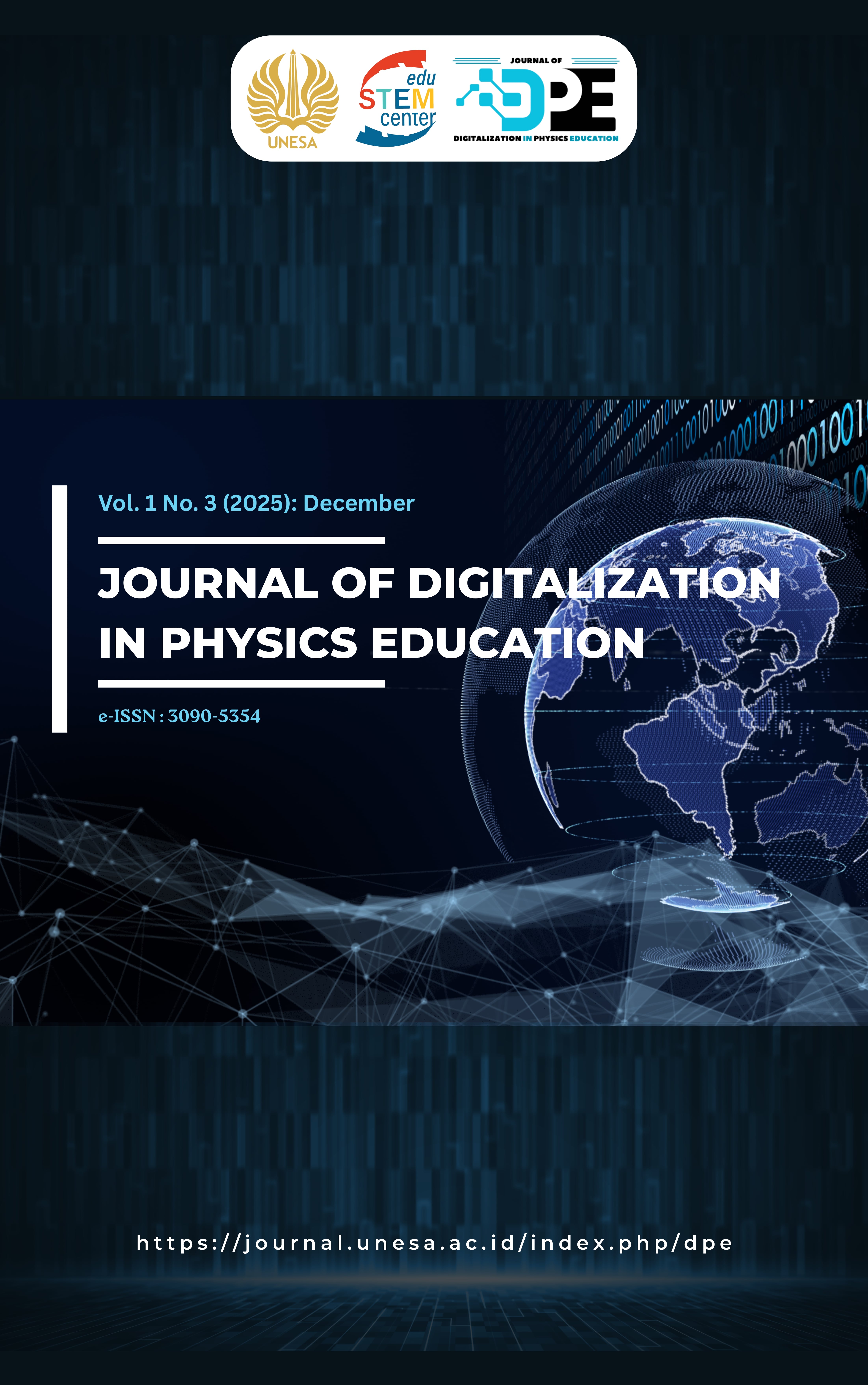Physics Learning with the Problem Based Learning (PBL) Model Based on Electronic Liveworksheets to Improve Critical Thinking Skills
DOI:
https://doi.org/10.26740/jdpe.v1i3.42583Keywords:
Critical Thinking Skills, Electronic Liveworksheets, Physics Learning, Problem Based Learning, Temperature and HeatAbstract
Objective: This study aims to determine the effectiveness of the Problem-Based Learning (PBL) model based on electronic liveworksheets in improving students' critical thinking skills. Method: This research employed a quantitative quasi-experimental design with a pre-test and post-test control group. The study subjects were 64 eleventh-grade students from SMA Negeri 1 Bluluk, divided into an experimental class (PBL with electronic liveworksheets) and a control class (conventional PBL), each consisting of 32 students. Research instruments included learning implementation observation sheets, critical thinking skills test questions, and student response questionnaires. Data were analyzed using prerequisite tests (normality and homogeneity) and hypothesis tests (paired t-test, N-Gain, and Effect Size). Results: The results showed that the learning implementation reached a "Very Good" category with a percentage of 93.2%. The experimental class demonstrated a higher improvement in critical thinking skills with an N-Gain value of 0.50 (medium category) and an Effect Size of 0.70 (medium category), both of which were greater than those of the control class. Student responses to the use of electronic liveworksheets were also very positive, with all aspects receiving percentages above 85%. Novelty: The novelty of this research lies in the successful integration of the PBL model with electronic liveworksheets, which effectively overcomes the limitations of conventional PBL, such as time inefficiency and delayed feedback. This integration provides an interactive dimension and instant feedback that significantly increases student motivation, engagement, and critical thinking skills, making it an innovative and relevant solution for 21st-century learning.
References
Alwan, A. A. (2019). Misconception of heat and temperature among physics students. Procedia Social and Behavioral Sciences, 12, 600–614. https://doi.org/10.1016/j.sbspro.2011.02.074
Cohen, J. (1988). Statistical power analysis for the behavioral sciences (2nd ed.). Lawrence Erlbaum Associates.
Creswell, J. W. (2022). Research design: Qualitative, quantitative, and mixed methods approaches. Sage Publications.
Facione, P. A. (2011). Critical thinking: What it is and why it counts. Insight assessment, 1(1), 1-23.
Hake, R. R. (2002). Relationship of individual student normalized gain to class averages. The Physics Teacher, 40(2), 64–67.
Jatmiko, B., Prahani, B. K., Munasir, Supardi, Z. A. I., Wicaksono, I., Erlina, N., Pandiangan, P., Althaf, R., & Zainuddin. (2018). The comparison of oripa teaching model and problem based learning model effectiveness to improve critical thinking skills of pre-service physics teachers. Journal of Baltic Science Education, 17(2), 300–319. https://doi.org/10.33225/jbse/18.17.300
Khastini, R. O., Rohmah, W. S., & Sahida, A. N. (2023). The effectiveness of the e-student worksheets to improve students’ learning outcomes and critical thinking skills on digestive system concepts. International Journal of Biology Education Towards Sustainable Development, 3(1), 52–61. https://doi.org/10.53889/ijbetsd.v3i1.160
Maharani, P., & Hamid, M. A. (2024). Development of e-student worksheet based task-based learning through liveworksheets.com for high school students. AL-ISHLAH: Jurnal Pendidikan, 16(2), 1205–1217. https://doi.org/10.35445/alishlah.v16i2.5183
Mahliatussikah, H. (2022). Development of interactive learning media “lectora inspire” for balaghah learning. Proceedings of the International Seminar on Language, Education, and Culture (ISoLEC 2021), 612(ISoLEC), 128–133. https://doi.org/10.2991/assehr.k.211212.024
Nurlaela, L., Badriyah, N., Ismayati, E., & Ramadhani, I. F. (2020). The effect of problem-based learning and critical thinking skills on students’ learning outcomes of vocational schools. In 2nd International Conference on Social, Applied Science, and Technology in Home Economics (Iconhomecs), 275–279. https://doi.org/10.2991/assehr.k.200218.044
Riduwan. (2015). Metode dan teknik menyusun proposal penelitian. Alfabeta.
Rusdan, M., & Mulya, D. B. (2023). The effect of using live worksheet-based electronic worksheets to measure cognitive learning outcomes. Edunesia: Jurnal Ilmiah Pendidikan, 4(3), 983–998. https://doi.org/10.51276/edu.v4i3.481
Savery, J. . (2015). Overview of problem-based learning: Devinition and distinction interdisciplinary. Journal Problem-Based Learning, 1(1), 9–20. https://doi.org/10.7771/1541-5015.1002
Suryantika, I., & Aliyyah, R. R. (2023). Implementasi kurikulum merdeka: strategi pembelajaran di luar kelas pada sekolah dasar. Karimah Tauhid, 2(6), 3103–3134.
Tiruneh, D. T., De Cock, M., & Elen, J. (2018). Designing learning environments for critical thinking: Examining effective instructional approaches. International Journal of Science and Mathematics Education, 16(6), 1065–1089. https://doi.org/10.1007/s10763-017-9829-z
Widiastuti, I. A. M. S., Mantra, I. B. N., Utami, I. L. P., Sukanadi, N. L., & Susrawan, I. N. A. (2023). Implementing problem-based learning to develop students’ critical and creative thinking skills. JPI (Jurnal Pendidikan Indonesia), 12(4), 658–667. https://doi.org/10.23887/jpiundiksha.v12i4.63588
Downloads
Published
How to Cite
Issue
Section
License
Copyright (c) 2025 Journal of Digitalization in Physics Education

This work is licensed under a Creative Commons Attribution 4.0 International License.
 Abstract views: 80
,
Abstract views: 80
, PDF Downloads: 71
,
PDF Downloads: 71
, PDF Downloads: 30
PDF Downloads: 30


